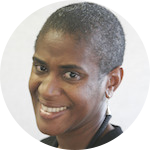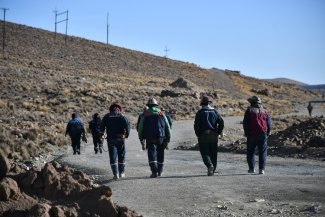Dana White has become an advocate for the families of missing teenagers ever since her 15-year-old daughter Dayanna began running away from home last year.
Fifteen-year-old Dayanna White had run away from, and returned, home at least half a dozen times before the social worker came to her family’s dim, cramped apartment in a predominantly African-American neighbourhood in south-west Washington DC this April.
“Come in!” Dana White, the teen’s mother, remembers telling the visitor. “Help me help my kid.”
Although Dayanna had been back for several weeks when the social worker visited, this was the first time that Dana had felt hopeful that the authorities were seeking new ways to persuade her daughter, one of seven siblings, to stop running away.
The social worker didn’t appear by chance. A month earlier, in March, DC police tweeted a number of alerts about missing teenagers in the US capital. The tweets were misinterpreted as suggesting that 14 African-American and Latina girls had gone missing in just 24 hours. While incorrect, the misinformation went viral, helped along by well-meaning celebrities and fuelled by concerns that young girls of colour were being trafficked and nobody was paying any attention.
African-American children are disproportionately missing in the US. National crime statistics show that in 2016, African-Americans made up 38 per cent of missing Americans under the age of 18, despite only making up about 15 per cent of the nation’s youth population.
The Metropolitan Police Department (MPD) in Washington DC quickly came out to explain that there had not been a spike in the number of missing teens in their jurisdiction, but the issue still became a major news story. While the outrage over an abduction epidemic was misplaced, the episode did put the issue of missing black children on the national agenda.
Solving old problems with new media
When Commander Chanel Dickerson got promoted to lead the MPD’s Children and Family Services department last December, she decided to use new media to seek a solution to the old problem of missing teenagers. She knew that many cases were not being covered by the mainstream media, even though exposure can be vital in helping investigators. As an African-American, Dickerson told the New York Times that she wanted to “get the word out” about young people who reminded her of herself when she was growing up in DC.
Most of the missing teens highlighted in Dickerson’s first round of tweets were young women of colour. The tweets were simple: the words “critical missing,” a category used by police for those seen as especially vulnerable because they are under 15 or over 65 years old; a name; a photograph; a few details; and a number for anyone with information to call.
Dayanna, whose family calls her Day-Day, was the subject of such a tweet after she ran away from home on 4 March. She was pictured with braids pulled back from a solemn expression. Two and a half weeks later, a 22 March tweet reported that she had been found. DC police say that nearly all of the hundreds of people reported missing every year are found and that the number reported has been decreasing in recent years.
Dana tells Equal Times that whenever Dayanna had gone missing in the past she would notify the police before searching for her daughter, either on foot or by car. Every time that she found Dayanna, she would cajole or order her to come home. But until the tweets started, Dana says she had not understood the scope of the problem. Only then did she realise that many “other parents were begging and pleading and crying for help.”
Dana says her daughter first began running away last year when the family moved from another part of DC to a new low-rent apartment in a black-majority neighbourhood.
The population of the nation’s capital is just under 700,000, and while black people make up close to 50 per cent of the population, they are disproportionately affected by poor housing, poor healthcare, underfunded schools and under- or unemployment.
Dana thinks that her daughter has been negatively influenced by one of her new friends. Although Dana doesn’t allow Dayanna to stay with this friend because she has not met her parents, Dayanna, nonetheless, may stay with her friend’s family when she runs away. She has told her mother that the friend’s father gives her and his daughter a liberal allowance, causing Dana to worry that her daughter is being groomed to sell drugs or her body.
Debby Shore founded Sasha Bruce Youthwork in 1974, a non-profit which provides shelter, counseling, jobs and other training for hundreds of young people and their families in the DC area every year. She tells Equal Times that teenagers often leave home because they are fleeing abusive or addicted parents, because of conflict with their elders over sexual orientation or disciplinary steps, or out of a belief they can help their impoverished families by striking out on their own. Some teens are also lured away by, or end up in the grip of, sex traffickers.
“Our people are missing at an alarming rate”
The perceived and real lack of attention given to missing children of colour was at heart of the #MissingDCGirls Twitter storm that took place earlier this year. When newspapers and broadcasters pay more attention “when it’s 12-year-old Michael, and not 12-year-old Malik,” social media posts about unreported abductions can seem plausible, says Janni Aragon, a political scientist at the University of Victoria, British Columbia in Canada who focuses on media and culture.
For Mike Ananny, a journalism and communications professor at the University of Southern California, one important take away for police from this episode should be that social media cannot tell the whole story. After Commander Dickerson’s initial tweets, the DC police department added a dedicated web site to provide more context about its efforts. Police also need to get the attention of traditional media, Ananny says, acknowledging that can be hard.
Natalie Wilson, who works in public relations in Washington DC, says that the outcry over the tweets showed the pressure experienced by African-Americans who feel that they are losing ground in a gentrifying city.
In 1980, 70 per cent of Washington DC’s population was black. By 2000, that percentage fell to 61 per cent; in 2010 it was 50.7 per cent and last year, African-Americans only made up 47.7 per cent of the population due in part to rising housing costs and falling incomes.
In 2008, Wilson and her sister-in-law Derrica Wilson, a veteran law enforcement officer, founded the Black and Missing Foundation to help African-American families across the country find missing loved ones. They were inspired by a 2004 case in South Carolina in which a family struggled to draw attention to the disappearance of a young black woman whose boyfriend later confessed to murdering her. Today, Natalie and Derrica Wilson coach families on how to approach traditional media. The also try to educate black families they find aren’t always aware that in the age of social media it is easier for abusers to manipulate impressionable and naïve young girls.
“We couldn’t just sit back and say, ‘This is someone else’s problem,” Natalie tells Equal Times. “Our people are missing at an alarming rate.”
“It is on us”
In response to the Twitter storm, DC Mayor Muriel Bowser announced steps that included adding more officers to Commander Dickerson’s division; working with NGOs to provide more support to families; and devoting more funds to organisations such as Sasha Bruce Youthwork.
National Network for Youth executive director Darla Bardine, who advocates for homeless young people, says she has seen other large urban cities struggle to maintain the “collaborative focus” that Bowser outlined, in part because so many other problems demand attention. Bardine says it will take money, leadership and community involvement for DC’s initiative to come fully to fruition.
“It is on us to step up and really help young people,” she says.
In recent months, Dayanna’s mother has devoted weekends to handing out leaflets about missing teens on behalf of other families. Long unemployed and disabled by arthritis, 38-year-old Dana has also started taking online criminology courses in the hope that one day she will work with the families of missing children.
Dayanna is currently living in a shelter where she is receiving counseling and is subject to the kind of discipline her mother admits that she struggled to maintain at home. Dayanna, whom Dana proudly describes as an A and B student, called home from the shelter one morning to get her mother’s advice on summer school, and Dana continues to be involved with Dayanna’s education.
The social worker that visited the Whites in April did not offer much advice that Dana hadn’t figured out herself over a stressful year. But Dana is hopeful that earlier intervention under Bowser’s plan will help others.










